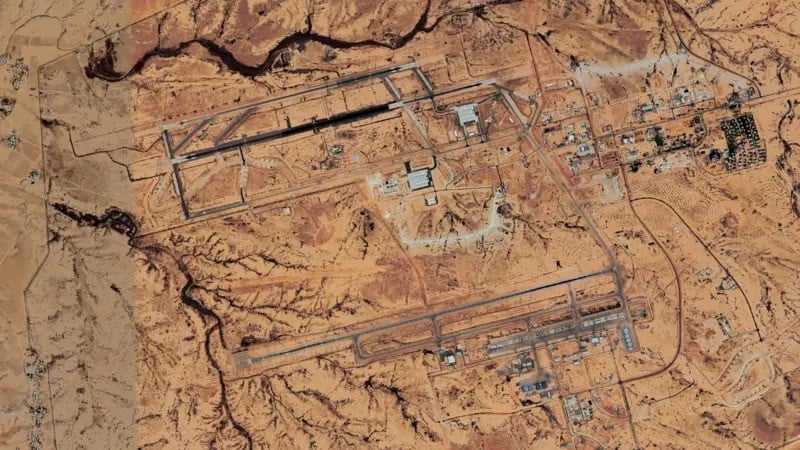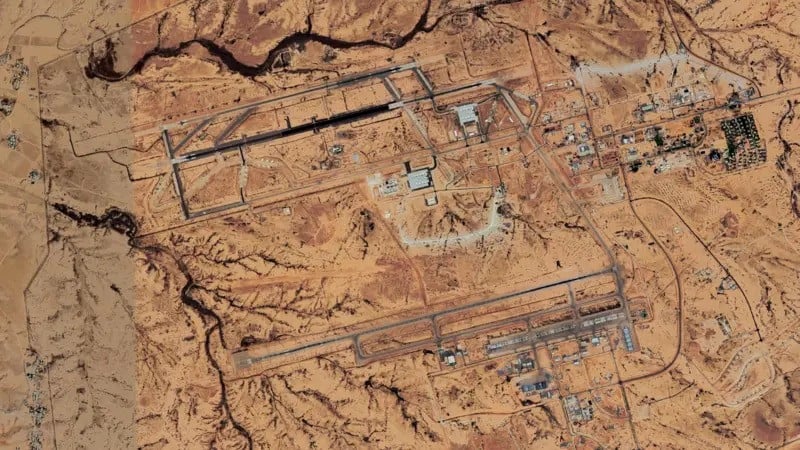ghazi52
PDF THINK TANK: ANALYST

- Joined
- Mar 21, 2007
- Messages
- 103,045
- Reaction score
- 106
- Country
- Location
Satellite images show damage on Israeli air base after Iranian attack
Nevatim air base in southern West Bank shows major changes in satellite images taken between April 12 and 14News Desk
April 24, 2024

Nevatim Airbase, located in the southern West Bank and west of the Dead Sea. PHOTO: GOOGLE MAPS
JOIN OUR WHATSAPP CHANNEL
Following the events of April 13 when Iran launched an attack on Israel, conflicting reports have emerged regarding the success and impact of the assault. While Iran boasts of a successful strike, Israel contends that the attack was thwarted.
A BBC report analysed the satellite imagery to unravel the facts surrounding Iran's attack on Israel and the subsequent Israeli response.
Iran's aerial assault on Israel on April 13 was in retaliation to an attack on its embassy in Damascus, dubbed "Vada Sadiq" by Iran. Reports indicate that Iran deployed approximately 300 missiles and suicide drones during the early hours of that day. However, Israel claimed to have intercepted most of these projectiles with the aid of the 'Aero' air defence system and regional allies, averting significant damage to Israeli territories.
According to Israeli military sources, Iran's attack comprised 170 drones, 120 ballistic missiles, and 30 cruise missiles, executed in three phases targeting military installations rather than civilian centres.
The Aerospace Force of Iran's Revolutionary Guards, under the leadership of Amir Ali Hajizadeh, spearheaded this assault. However, precise details regarding the types and numbers of drones and missiles employed remain undisclosed.
Initial statements from the Revolutionary Guards on Iran's state television asserted that specific targets within Israel were hit using drones and missiles.
Subsequent reports showcased Iranian drones, Paveh cruise missiles, Emad-3 ballistic missiles, and other Iranian ballistic missiles like Khyber Shahkan and Kadir.

Iranian media have shown images of missiles and drones fired at Israel. PHOTO: IRIBNEWS
Iran claims to have struck the Nevatim air base and the Hermon intelligence base in the Golan Heights during the attack.
Satellite imagery analysis conducted by BBC sheds light on the aftermath of the attack, comparing images before and after the incident.
Notable changes, including damage to the Nevatim air base, have been observed. The base, strategically significant due to its proximity to Israel's Dimona nuclear facility, reportedly sustained minor damage, as confirmed by Israeli authorities. Images reveal alterations to the runway and infrastructure, corroborating reports of the attack's impact.

Location of Nevatim Air Base. PHOTO: MICROSOFT
Assessing damage and claims at Nevatim Airbase
Nevatim air base, located in the southern West Bank and west of the Dead Sea, has witnessed significant changes as depicted in satellite images taken between April 12 and 14.
These images reveal alterations in at least four locations within the base, notably on the runway where a large scar is visible post-attack. Israeli authorities have confirmed "minor" damage to the base, with repairs underway as showcased in a video released by the Israeli military.

Four place where damage is detected at Nevatim Base. Condition on April 12 (L) and April 13 (R). PHOTO: PLANET LABS (PBC)

Satellite images of the southern runway of Nevatim Base. Condition on April 12 (L) and April 13 (R). PHOTO: PLANET LABS (PBC)
The runway repairs captured in the video align with satellite imagery showing a major change in the same location, indicating the extent of damage caused by the Iranian attack. The proximity of the damaged area to the hangar of Israeli fighter jets highlights the strategic significance of this target.

IDF footage shows repairs to the sou
th runway near a hangar at the Navatim base. PHOTO: SCREENGRAB
While Israel downplays the impact, Iran contends that the base houses Israeli F-35 stealth fighter jets allegedly involved in attacks on Iranian targets. However, Israel has neither confirmed nor denied these claims.
According to former United Nations weapons inspector Scott Reiter, "Nevatim air base was hit by five to seven missiles." American network ABC quoted some Israeli sources as saying that the base was hit by five missiles.
Hermon intelligence base and Ramon Airbase
BBC also delved into the details surrounding Hermon's intelligence base in Israel and the claims made by both sides in the aftermath of the conflict.
Hermon's intelligence base, situated in the Golan Heights near the Syria-Iraq border, holds strategic importance as the reputed headquarters of Israel's crucial military intelligence unit 8200.
Responsible for electronic intelligence, 8200 is considered Israel's largest and most critical intelligence unit. The base's proximity to volatile border regions underscores its significance in gathering crucial information for Israeli security operations.
During the conflict, Iranian Revolutionary Guards claimed that Hermon's intelligence base was involved in gathering intelligence for an attack on their consulate, thus justifying Iran's targeting of the base.
However, the lack of ground evidence and specific site data makes it challenging to ascertain the nature and extent of any damage inflicted on the base.
Iranian state media alleged that the Ramon air base was also successfully targeted. Still, Israeli authorities have refuted these claims, citing a lack of substantial evidence and ground verification.
Mohammad Baqheri, chief of staff of Iran's armed forces, specifically named Hermon intelligence base and Nevatim air base as targets in a television interview, further highlighting the conflicting narratives surrounding the targets of the attacks.
Satellite imagery comparisons conducted post-attack have revealed minimal changes near the targeted military bases, with no significant evidence of damage or alterations.

Satellite images show Israeli air base damage from Iranian attack | The Express Tribune
Nevatim Airbase in southern West Bank shows major changes in satellite images taken between April 12 and 14






